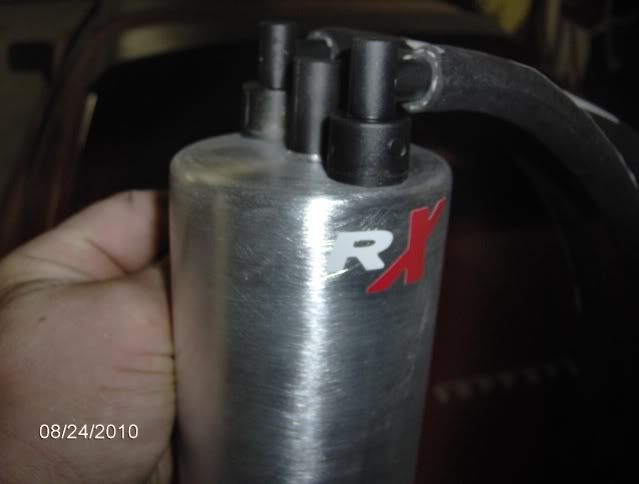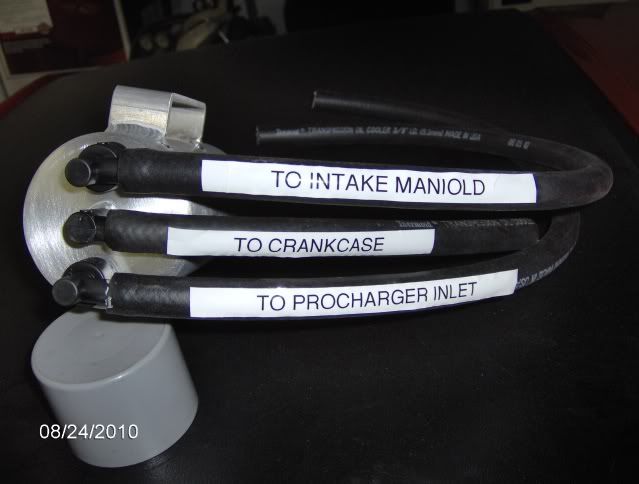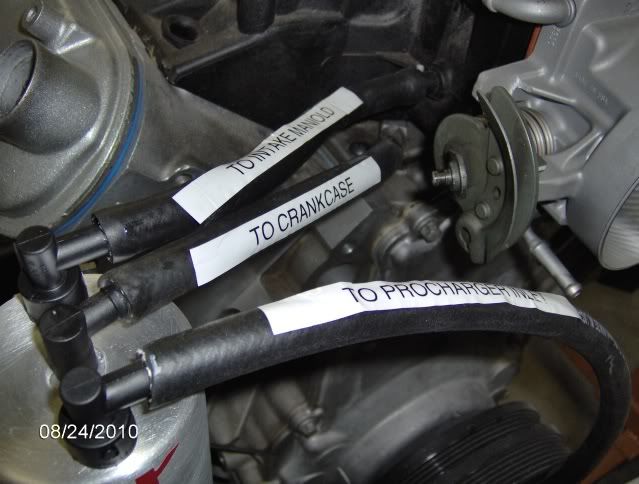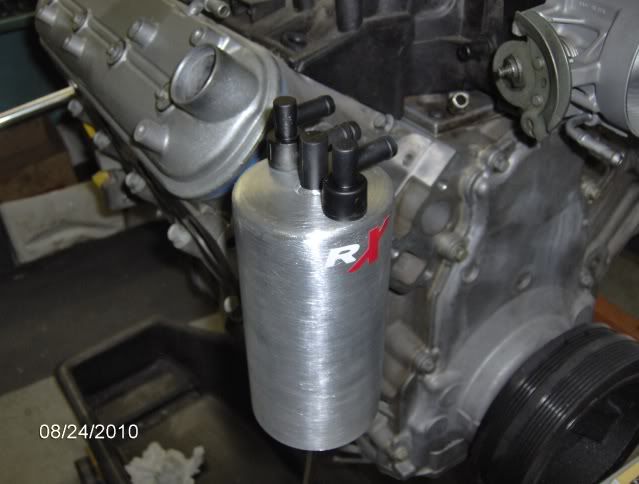CATCH CAN.. what brand and were are you mounting them?
#13
Here is what he wrote "Since the vast majority of supercharged or turbo charged builds have less than adequate PCV systems, I thought I would offer up a thread for disscusions on the subject.
First, the history of crankcase ventalation & how it has progressed over time:
To understand why we need a proper PCV system one must understand what takes place in the crankcase during the average day of driving. First off, all internal combustion engines have a certain amount of "blow-by" or leakage past the piston rings into the crankcase. This consists of several compounds such as unburnt fuel and a small amount of the combustion gasses that result from the explosion of the air/fuel mixture. The combustion gasses contain several nasty things including sulfuric acid, carbon particles, and other caustic compounds that will contaminate the oil over time. In the crankcase there is also a certain amount of water, or moisture from condensation. Even if never run, an engine will accumulate moisture from the heat of the day to the coolness of the evening depending on how humid the climate is where the motor lives. Every time the motor gets run up to operating temperature these compounds are "gassed off" and with the OEM system it all gets "flushed" or pulled into the intake manifold where it is mixed with the intake air charge and burned in the combustion process and further in the catalytic converter before it is exhausted into the air as mostly just water vapor at that time. Now of course, a small amount keeps leaking past the rings into the crankcase and completes the cycle all over again, but without a proper vacuum pulled ventilation system....these nasty compounds will break down the oil and reduce its protection properties and the corrosive aspects start to rust internal parts resulting in reduced engine life.
In the "old days" of our grandfathers, the engineers that designed engines new the importance of evacuating these nasty compounds and the design was extremely simple. First was nothing more than plain breathers to allow excess crankcase pressure to be released or vented. But the damage from not "flushing" all the gasses out resulted in very short engine life (of course the oils of that day were nothing like the protection today's synthetics provide) so the next change added a vent tube, or evacuation tube that ran from the top of the crankcase to low on the car where the air streaming past would create a suction, or vacuum that would pull the vapors out and vent them directly into the air with a breather (barely filtered with a wire mesh type media that was oiled to catch dust & dirt) allowing the "fresh" makeup air in to complete the flushing process. Now this resulted in greatly increased engine life, but as the motors got worn oil would start to drip out the tube and drip onto the roadways, then the rain would wash it into the ditches, where it would enter the ground water (you know the rest of the EPA story) and the gasses just vented to the air.
As the EPA and the powers that be mandated stricter emission laws the system was refined more and more ultimately evolving into what we have today. A completely sealed system that uses the vacuum provided by the intake manifold to draw these vapors out, and the filtered fresh makeup air is drawn from the main air intake system and filtered by the main air filter. This results in very clean emissions, but the unintended issues are the detonation or "knock" that occurs when oil is introduced into the combustion chamber that the knock sensors pick up (before we can hear it) and pull timing to protect the engine from damage, and thus reduced power. Another result is the carbon buildup on the valves & piston tops (any techs reading this can surely verify the amount) also resulting in decreased performance and less power made.
The purpose of a proper oil separating catch can is to route these gasses through a baffle system that provides the most contact possible with the outer surface resulting in the oil being trapped and removed from the other gasses that do continue on through the intake and are burnt and consumed. It does NOTHING else in ANY way to the engine oil itself....it can't.
Deleting your PCV system:
While this will insure NO oil the the intake tract via the PCV, it will greatly shorten the life of your engine if street driven. The worst example I have seen is to cap off all the fittings and run an open hose from each valve cover to near the ground. One would think “they are both releasing pressure, so what can it hurt”. The answer is plenty. Lets take the basic principle of the Venturi effect. Whip a piece of hose around in a circle so that air rushes past the end. This will result in suction from the end of the hose near the center of the radius. Now with a car traveling down the road at speed, both hose will have air traveling past the ends and one ultimately will have more air rushing past thus creating more suction, and the other will them become a vacuum tube sucking up dust, dirt, water, sand, etc. directly into the engine from the side with the least suction. Depending on the amount of dust & dirt on the roads you travel (just look under your hood to see all the sand & dust that accumulates on the engine exterior). So it may take years to destroy your engine this way, or it may take no time at all. To see this if you have been misguided into doing this just remove each valve cover, and looking up into the baffle in each you will see the accumulated dirt built up as it comes in contact with the oil.
Now, addressing the "Home Depot" oil separator, it will and does catch a small amount of the oil but the majority still gets past into the intake (we used these and then the other cans that popped up on the market through the years before designing the ultimate final product that is offered today) and the reasons are simple:
It is plastic and transfers heat very inefficiently so very little condensing takes place.
The size. Anything less than 1 qt capacity and there is not enough surface area to be as functional, and the volume needs to be enough to allow the flow to slow enough for the oil to drop out of suspension.
And the lack of an effective baffle system allow oil to be pulled directly through.
As for having steel wool or another type of filter media inside, this will work well at first to trap oil....but as soon as it gets saturated droplets are pulled off and into the intake.
Why don't the auto manufacturers incorporate something similar? Cost and the added maintenance was deemed something that would NOT be accepted by the general market. (even though it is as simple as draining the can at each oil change).
Bottom line is this: The OEM system does a great job of meeting emission standards and removing the harmful contaminants, but the unintended consequences are the oil that is drawn into the intake charge. For an engine to produce the maximum amount of energy per explosion (of the A/F in the combustion chamber) you want air & fuel only....any amount of oil in this mix will hamper the explosion resulting in less energy released, detonation, and carbon buildup. Trapping and removing this oil before it gets into the combustion chamber is the ONLY solution to maintaining the maximum efficiency and prevent excess carbon buildup.
Now how this applies to forced induction. (Procharger/Vortech/Paxton style & turbo's both single & twin). (This does not apply to top mount twin screw types, I will cover that in the next installment).
The vast majority of kits available come with a rudimentry PCV mod, that only evacuates the crankcase part of the time, and is barely effective at best. The issue is if the vacuum from the intake manifold is used to pull out the harmful combustion byproducts, when under boost the crankcase can become pressurized by the boost causing seal & oil leaks, as well as oil vapors/mist being introduced to the intake air charge resulting in detonation & lost power.
To counter this, most kits will include a line to run to the inlet side of the head unit pulling the gasses into the intake charge to be burnt during combustion & further in the cats. The problems are this is only marginally succesfull in properly "flushing" the crankcase of the harmful compounds that are introduced during combustion.
To delete the system alltogether and vent with breathers alone will relieve the excess pressure, but do nothing to remove the majority of the harmful combustion byproducts (unburnt fuel, carbon paticles, sulfuric acid, water, etc.) that shorten your engine life and result in slowley damaging the internal parts. Even worse than this is when the PCV system is deleted alltogether and open hoses are run from the valve covers to near the ground where dirt, dust, water, sand, etc. are sucked directly into the engine. BEWARE OF THIS MOD!!!! Very detrimental to an engine." Tracy
First, the history of crankcase ventalation & how it has progressed over time:
Understanding PCV Systems
To understand why we need a proper PCV system one must understand what takes place in the crankcase during the average day of driving. First off, all internal combustion engines have a certain amount of "blow-by" or leakage past the piston rings into the crankcase. This consists of several compounds such as unburnt fuel and a small amount of the combustion gasses that result from the explosion of the air/fuel mixture. The combustion gasses contain several nasty things including sulfuric acid, carbon particles, and other caustic compounds that will contaminate the oil over time. In the crankcase there is also a certain amount of water, or moisture from condensation. Even if never run, an engine will accumulate moisture from the heat of the day to the coolness of the evening depending on how humid the climate is where the motor lives. Every time the motor gets run up to operating temperature these compounds are "gassed off" and with the OEM system it all gets "flushed" or pulled into the intake manifold where it is mixed with the intake air charge and burned in the combustion process and further in the catalytic converter before it is exhausted into the air as mostly just water vapor at that time. Now of course, a small amount keeps leaking past the rings into the crankcase and completes the cycle all over again, but without a proper vacuum pulled ventilation system....these nasty compounds will break down the oil and reduce its protection properties and the corrosive aspects start to rust internal parts resulting in reduced engine life.
In the "old days" of our grandfathers, the engineers that designed engines new the importance of evacuating these nasty compounds and the design was extremely simple. First was nothing more than plain breathers to allow excess crankcase pressure to be released or vented. But the damage from not "flushing" all the gasses out resulted in very short engine life (of course the oils of that day were nothing like the protection today's synthetics provide) so the next change added a vent tube, or evacuation tube that ran from the top of the crankcase to low on the car where the air streaming past would create a suction, or vacuum that would pull the vapors out and vent them directly into the air with a breather (barely filtered with a wire mesh type media that was oiled to catch dust & dirt) allowing the "fresh" makeup air in to complete the flushing process. Now this resulted in greatly increased engine life, but as the motors got worn oil would start to drip out the tube and drip onto the roadways, then the rain would wash it into the ditches, where it would enter the ground water (you know the rest of the EPA story) and the gasses just vented to the air.
As the EPA and the powers that be mandated stricter emission laws the system was refined more and more ultimately evolving into what we have today. A completely sealed system that uses the vacuum provided by the intake manifold to draw these vapors out, and the filtered fresh makeup air is drawn from the main air intake system and filtered by the main air filter. This results in very clean emissions, but the unintended issues are the detonation or "knock" that occurs when oil is introduced into the combustion chamber that the knock sensors pick up (before we can hear it) and pull timing to protect the engine from damage, and thus reduced power. Another result is the carbon buildup on the valves & piston tops (any techs reading this can surely verify the amount) also resulting in decreased performance and less power made.
The purpose of a proper oil separating catch can is to route these gasses through a baffle system that provides the most contact possible with the outer surface resulting in the oil being trapped and removed from the other gasses that do continue on through the intake and are burnt and consumed. It does NOTHING else in ANY way to the engine oil itself....it can't.
Deleting your PCV system:
While this will insure NO oil the the intake tract via the PCV, it will greatly shorten the life of your engine if street driven. The worst example I have seen is to cap off all the fittings and run an open hose from each valve cover to near the ground. One would think “they are both releasing pressure, so what can it hurt”. The answer is plenty. Lets take the basic principle of the Venturi effect. Whip a piece of hose around in a circle so that air rushes past the end. This will result in suction from the end of the hose near the center of the radius. Now with a car traveling down the road at speed, both hose will have air traveling past the ends and one ultimately will have more air rushing past thus creating more suction, and the other will them become a vacuum tube sucking up dust, dirt, water, sand, etc. directly into the engine from the side with the least suction. Depending on the amount of dust & dirt on the roads you travel (just look under your hood to see all the sand & dust that accumulates on the engine exterior). So it may take years to destroy your engine this way, or it may take no time at all. To see this if you have been misguided into doing this just remove each valve cover, and looking up into the baffle in each you will see the accumulated dirt built up as it comes in contact with the oil.
Now, addressing the "Home Depot" oil separator, it will and does catch a small amount of the oil but the majority still gets past into the intake (we used these and then the other cans that popped up on the market through the years before designing the ultimate final product that is offered today) and the reasons are simple:
It is plastic and transfers heat very inefficiently so very little condensing takes place.
The size. Anything less than 1 qt capacity and there is not enough surface area to be as functional, and the volume needs to be enough to allow the flow to slow enough for the oil to drop out of suspension.
And the lack of an effective baffle system allow oil to be pulled directly through.
As for having steel wool or another type of filter media inside, this will work well at first to trap oil....but as soon as it gets saturated droplets are pulled off and into the intake.
Why don't the auto manufacturers incorporate something similar? Cost and the added maintenance was deemed something that would NOT be accepted by the general market. (even though it is as simple as draining the can at each oil change).
Bottom line is this: The OEM system does a great job of meeting emission standards and removing the harmful contaminants, but the unintended consequences are the oil that is drawn into the intake charge. For an engine to produce the maximum amount of energy per explosion (of the A/F in the combustion chamber) you want air & fuel only....any amount of oil in this mix will hamper the explosion resulting in less energy released, detonation, and carbon buildup. Trapping and removing this oil before it gets into the combustion chamber is the ONLY solution to maintaining the maximum efficiency and prevent excess carbon buildup.
Now how this applies to forced induction. (Procharger/Vortech/Paxton style & turbo's both single & twin). (This does not apply to top mount twin screw types, I will cover that in the next installment).
The vast majority of kits available come with a rudimentry PCV mod, that only evacuates the crankcase part of the time, and is barely effective at best. The issue is if the vacuum from the intake manifold is used to pull out the harmful combustion byproducts, when under boost the crankcase can become pressurized by the boost causing seal & oil leaks, as well as oil vapors/mist being introduced to the intake air charge resulting in detonation & lost power.
To counter this, most kits will include a line to run to the inlet side of the head unit pulling the gasses into the intake charge to be burnt during combustion & further in the cats. The problems are this is only marginally succesfull in properly "flushing" the crankcase of the harmful compounds that are introduced during combustion.
To delete the system alltogether and vent with breathers alone will relieve the excess pressure, but do nothing to remove the majority of the harmful combustion byproducts (unburnt fuel, carbon paticles, sulfuric acid, water, etc.) that shorten your engine life and result in slowley damaging the internal parts. Even worse than this is when the PCV system is deleted alltogether and open hoses are run from the valve covers to near the ground where dirt, dust, water, sand, etc. are sucked directly into the engine. BEWARE OF THIS MOD!!!! Very detrimental to an engine." Tracy
#15
continuation
"The solution? You need filtered fresh air to rplace the gasses pulled or flushed from the crankcase. This is provided in most case by the OEM or aftermarket air filter, or a added filtered breather (ideal is clean air entering one valve cover, and traveling through the entire crankcase with the harmfull compounds & pressure evacuated out the opposite one) provide for this. I prefeer to pull from the rear of the drivers side, and have the fresh air enter from the pass side. If in a non-emmissions state or off-road/race an optional filtered oil fill cap works nicely.
Then a proper oil seperating catchcan to trap the oil mist/vapors from reaching the intake air charge.
Here is a picture of a purpose built FI oil separating catchcan with labels to help understand:




How is this configured? Either dual inline checkvalves that will allow the intake manifold vacuum to pull during non-boost running, and close when the manifold is pressurized under boost running. Then the inlet side of the head unit/turbo will provide suction when under boost with another inline checkvalve in the line running to the inlet that allows it to open when boost is forcing the intake manifold vacuum line valve closed.
This provides proper crankcase evacuation in both non-boost (idle & moderate driving) and during WOT boosted operation.
PM me with your email and a request for the entire file of application diagrams.
You will note from the picture showing the type of can with dual integrated checkvalves that the inline checkvalves can be avoided, and no need to "T" into the outlet line from the can to the FI head unit inlet side. It does it all with 3 simple connections, but any catch can can be used with inline checkvalves.
So following all of this? Lets take time to get some questions before I go further.:thumbsup:" Tracy
"The solution? You need filtered fresh air to rplace the gasses pulled or flushed from the crankcase. This is provided in most case by the OEM or aftermarket air filter, or a added filtered breather (ideal is clean air entering one valve cover, and traveling through the entire crankcase with the harmfull compounds & pressure evacuated out the opposite one) provide for this. I prefeer to pull from the rear of the drivers side, and have the fresh air enter from the pass side. If in a non-emmissions state or off-road/race an optional filtered oil fill cap works nicely.
Then a proper oil seperating catchcan to trap the oil mist/vapors from reaching the intake air charge.
Here is a picture of a purpose built FI oil separating catchcan with labels to help understand:




How is this configured? Either dual inline checkvalves that will allow the intake manifold vacuum to pull during non-boost running, and close when the manifold is pressurized under boost running. Then the inlet side of the head unit/turbo will provide suction when under boost with another inline checkvalve in the line running to the inlet that allows it to open when boost is forcing the intake manifold vacuum line valve closed.
This provides proper crankcase evacuation in both non-boost (idle & moderate driving) and during WOT boosted operation.
PM me with your email and a request for the entire file of application diagrams.
You will note from the picture showing the type of can with dual integrated checkvalves that the inline checkvalves can be avoided, and no need to "T" into the outlet line from the can to the FI head unit inlet side. It does it all with 3 simple connections, but any catch can can be used with inline checkvalves.
So following all of this? Lets take time to get some questions before I go further.:thumbsup:" Tracy



